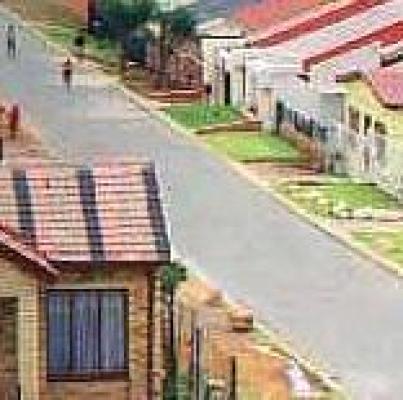Soweto is a former township from the times of Apartheid. Starting about 15 km away from the centre of Johannesburg, it comprises some 63 sq. km, where an estimated thee million people live.
Originally there were only temporary living quarters for the mine workers, before Soweto was declared a ghetto for the black population of Johannesburg by the infamous "Urban Areas Act" in 1923.
Soweto is a city of contrasts: luxurious mansions across the road from tin shanties, green fields and streams around the corner from piles of garbage, the biggest public hospital in the world with the world's highest HIV infection rate, and a friendliness and cheerfulness that disguises a high unemployment rate.
Although the government had a housing program to build hundreds of thousands of plain two-room houses here, the illegal squatter camps kept on growing and spreading.
Still Soweto is by no means only an accumulation of tin shacks. There are also better suburbs and a large number of social institutions like schools and hospitals.
There are three main kinds of transport in the township: minibus taxis, buses and trains. Most people take taxis because they are fast and cheap and stop anywhere, although regard them as dangerous.
Activities
Places to visit includes:
African Institute of Art & Funda Community CentreIt was formed in 1984 as a response to a need for an alternative art education programme that could enable ordinary people to access education in the visual arts.
Avalon CemeteryIn Avalon Cemetery in Soweto there are thousands of cots demarcating graves. The custom comes from Mpumalanga where traditionally, rocky soil meant that graves could not be dug very deep, and rocks were placed over them to prevent animals from digging up the bodies. To reinforce this effort, metal rectangular cots were positioned over the graves.
EKhaya Soweto Neighbourhood MuseumLocal arts and crafts on display, many made from recycled materials; the exhibits change as the centre undergoes continuous renewal.
Hector Petersen SquareNamed after one the first students to be killed in 1976 rebellion, a moment movingly captured by the camera. There is a monument to Petersen and his fellow friends in the square.
Nelson Mandela's HouseThe modest bungalow where Mandela and his wife Winnie lived in the 1950s and early 1960s, before he went to prison and she into exile in the Free State. In 1990 with the return of Mandela he find it to small and Winnie later transformed it into a museum. It's in Vilakazi Street, where Nobel Laureate Desmond Tutu also had a home.
Regina Mundi ChurchSoweto's largest Roman Catholic place of worship; more notable perhaps for its place in history (it served as a gathering place during the years of struggle) than its architecture. It also houses an art gallery.
Freedom SquareIt is the place where the Freedom Charter was adopted as the guiding document of a broad alliance of various political and cultural formations to map a way forward in the repressive climate of the 1950s.
The charter was the guiding document of the African National Congress and envisaged an alternative non-racial dispensation in which "all shall be equal before the law."
Where to StayAccommodation in Johannesburg Metropole are found in areas such as
Soweto,
Sandton,
Johannesburg City,
Randburg,
Roodepoort,
Benoni and
Kempton Park near OR Tambo Int Airport.
Other Things to DoJohannesburg offers a host of attractions and activities, and offers the visitor many
things to do.



